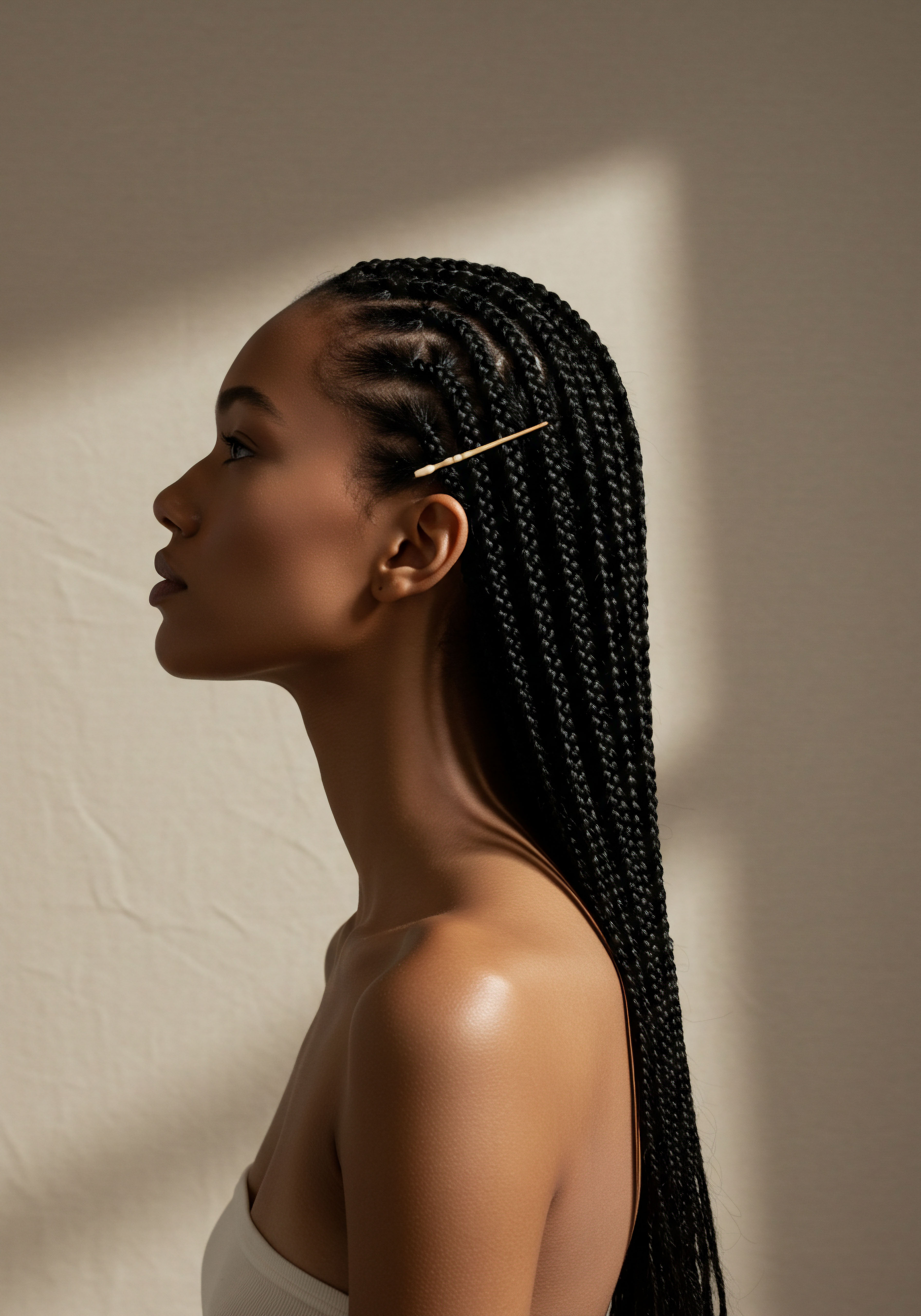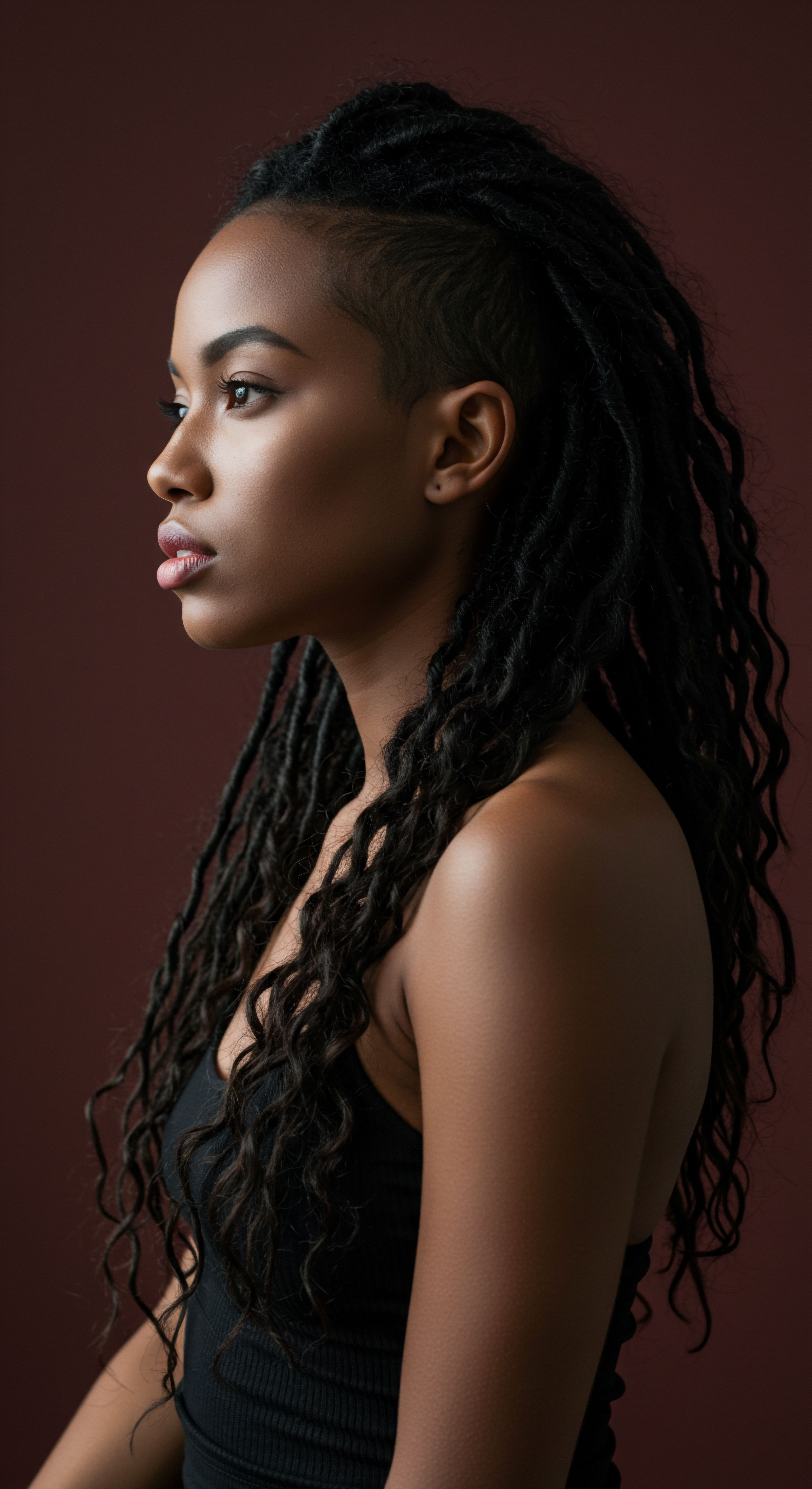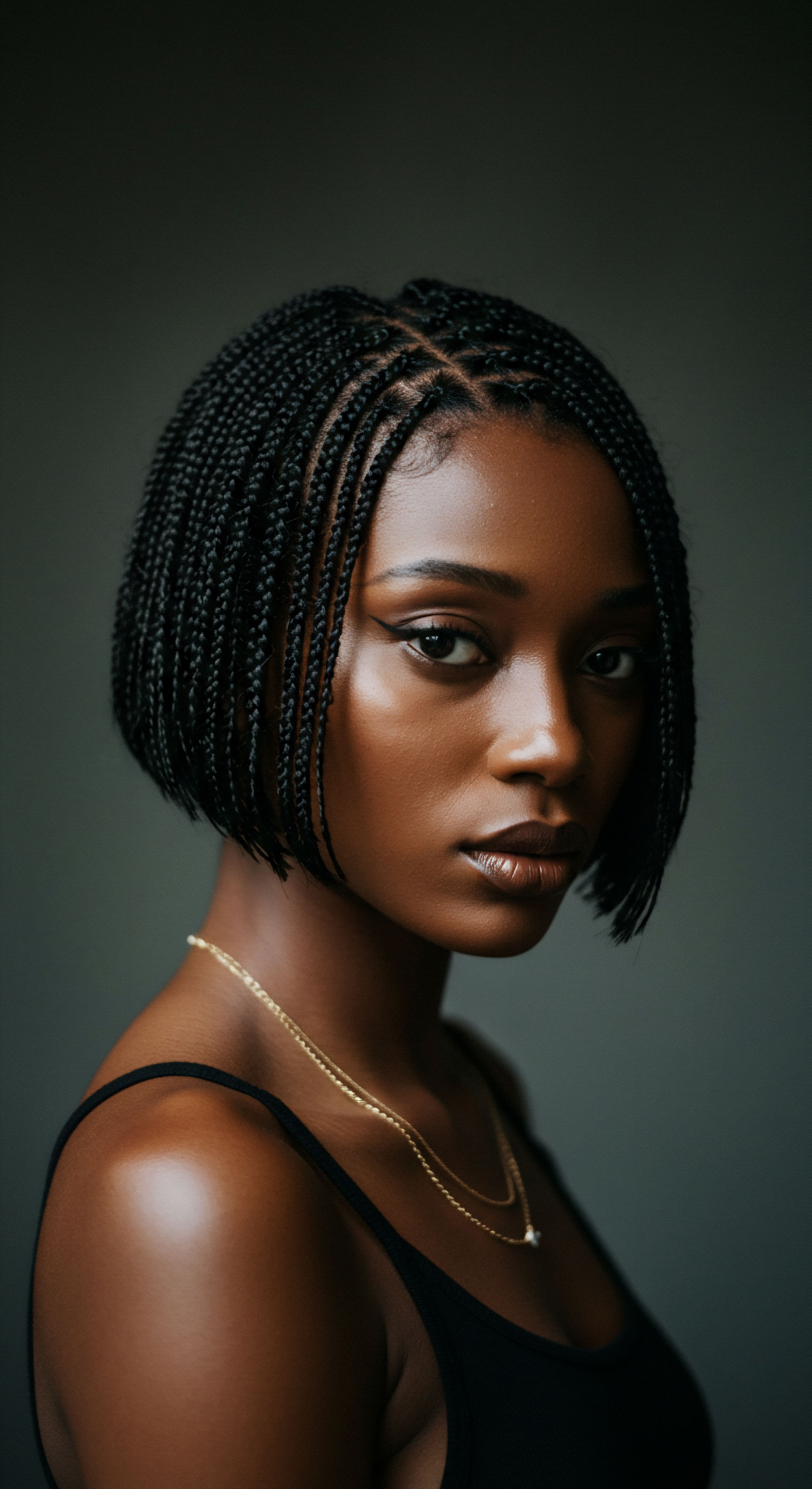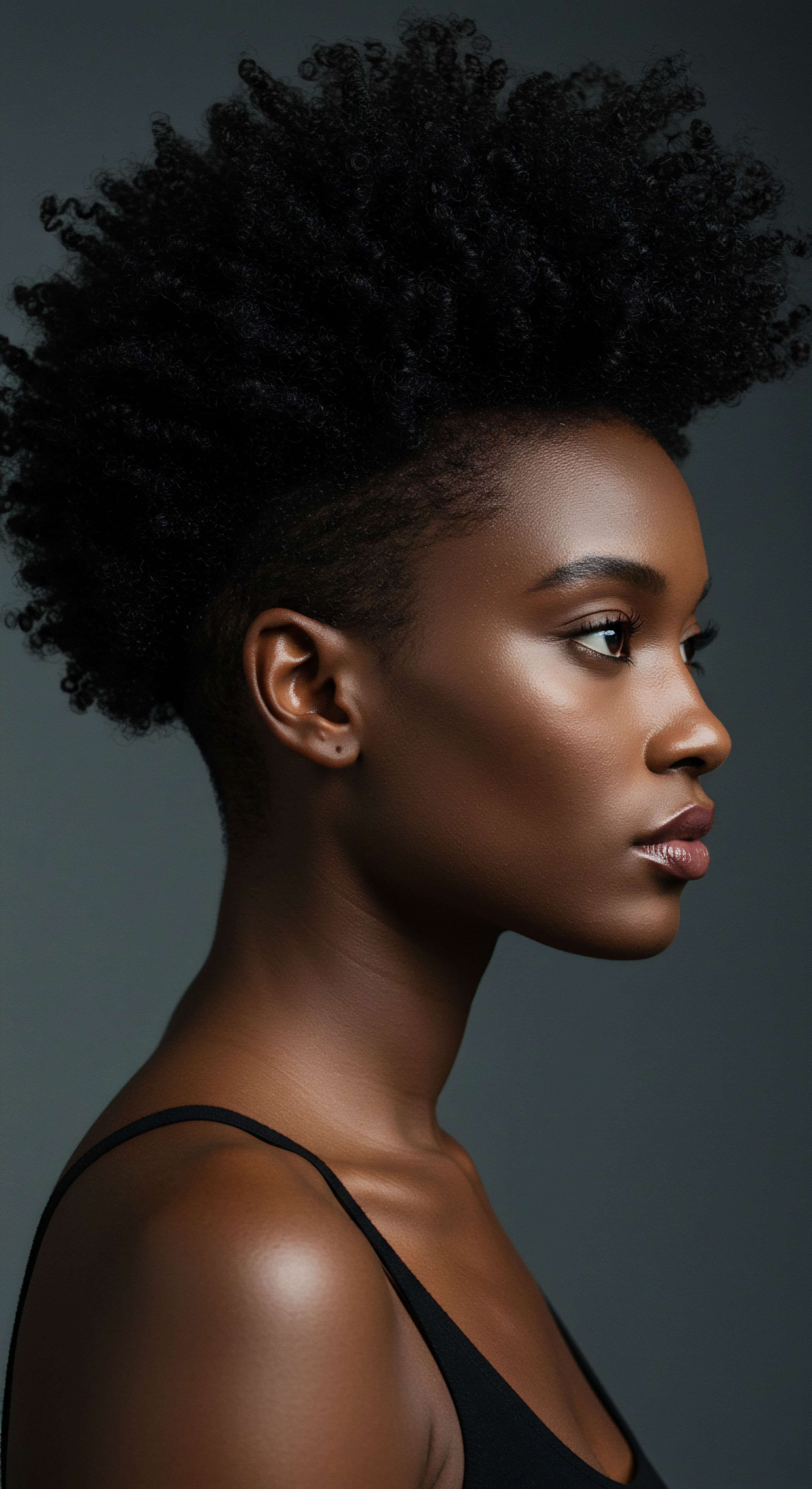
Roots
A quiet wonder often settles when we consider the enduring legacies of civilizations past. How did daily life unfold for those who walked ancient pathways, their aspirations and concerns echoing our own across millennia? For those of us who tend to textured hair, a particular curiosity often arises ❉ what ancient wisdom did they hold concerning the crowning glory, the very strands that adorn the head?
The sun-drenched lands of ancient Egypt, cradled by the Nile, offer a compelling glimpse into a world where personal presentation, including hair care, held deep meaning. Their approach was not merely cosmetic; it was interwoven with spiritual beliefs, social standing, and practical considerations for survival in a demanding climate.
The foundations of ancient Egyptian hair adornment rest upon a rich understanding of available resources and a keen eye for aesthetic detail. While direct written records detailing every hair concoction are scarce, archaeological findings and scientific analyses provide a window into their beauty practices. These revelations paint a picture of resourceful individuals who utilized the bounty of their environment to cleanse, condition, and style their hair. The substances they favored often served multiple purposes, reflecting a practical ingenuity that blended hygiene with visual appeal.

What Components Formed Ancient Hair Preparations?
The palette of ancient Egyptian hair products drew heavily from nature’s offerings. Oils and fats formed the bedrock of their conditioning and styling agents. These emollients provided protection from the arid desert air, helped to manage dryness, and imparted a desired sheen to the hair. The specific sources of these fats and oils varied, yet their fundamental role remained constant across social strata.
- Plant-Based Oils ❉ Among the most prevalent were Castor Oil and Almond Oil, valued for their conditioning properties. Other vegetable oils, such as Sesame Oil, Balanos Oil, and Moringa Oil, also saw widespread use. These botanicals offered a spectrum of textures and aromas, each contributing to the desired hair condition.
- Animal Fats ❉ Ox, sheep, and fowl fats were commonly rendered and incorporated into various preparations. These animal-derived lipids provided a heavy, occlusive layer, aiding in moisture retention and offering a solid base for pomades and unguents.
- Resins and Gums ❉ Certain tree resins, while often associated with mummification, found their way into hair preparations, lending a stickiness that aided in holding styles. Myrrh gum resin, known for its aromatic and antimicrobial qualities, was a notable example.
The precise recipes for these ancient formulations are not always fully known, yet the consistent presence of these foundational ingredients across different archaeological sites points to a standardized, if orally transmitted, knowledge base. The application of these rich, fatty substances suggests a deliberate effort to counteract the drying effects of the desert environment, maintaining the hair’s suppleness and appearance.
Ancient Egyptian hair care relied heavily on natural oils and fats, offering protection and style in a dry climate.

How Did Climate Shape Ancient Hair Care?
The relentless sun and dry winds of Egypt profoundly influenced the hair care choices of its inhabitants. Hair, much like skin, requires robust protection in such conditions. The liberal application of oils and fats created a physical barrier against environmental stressors, mitigating moisture loss and preventing brittleness. This practical aspect underscores a deeper understanding of hair’s needs, even without modern scientific terminology.
The need for effective sun protection extended beyond skin to the scalp and hair itself. Thick applications of fatty substances could shield delicate strands from UV damage, preserving color and structural integrity. This protective layer also helped to deter parasites, a common concern in ancient times, adding another layer of practical benefit to their beauty rituals.
| Environmental Factor Arid Climate |
| Hair Challenge Presented Dryness, brittleness, static |
| Ancient Egyptian Solution Abundant use of plant and animal fats |
| Environmental Factor Intense Sun Exposure |
| Hair Challenge Presented UV damage, color fading, scalp burns |
| Ancient Egyptian Solution Thick oil coatings, wigs for protection |
| Environmental Factor Dust and Sand |
| Hair Challenge Presented Accumulation, abrasion |
| Ancient Egyptian Solution Cleansing rituals, heavy styling products to seal hair |
| Environmental Factor These adaptations highlight a sophisticated understanding of environmental impact on hair. |
This adaptive approach to hair care reveals a society that recognized the importance of practical solutions alongside aesthetic desires. The climate dictated not only the choice of products but also the frequency and method of their application, ensuring that hair remained a symbol of health and status.

Ritual
Stepping from the foundational substances to the practical application, we uncover the deliberate practices that shaped ancient Egyptian hair presentation. Hair care was rarely a hurried affair; it was a measured sequence of actions, often imbued with a sense of purpose and self-regard. The meticulousness observed in their daily lives extended to their personal grooming, reflecting a deep respect for their physical form and its connection to their spiritual existence. The very act of tending to one’s hair became a quiet ceremony, a moment of connection with oneself and the cultural expectations of the time.
Beyond simple hygiene, these practices served as expressions of identity and social standing. The styles, the adornments, and the very condition of the hair conveyed messages within their society. The ancient Egyptians did not merely apply products; they engaged in a careful process designed to achieve specific outcomes, from holding intricate styles to promoting perceived health and growth.

How Were Hair Products Applied and Utilized?
The application of hair products in ancient Egypt was a hands-on affair, likely involving warmth to soften fats and ensure even distribution. Combs, often crafted from materials like Fish Bones, played a role in working these preparations through the hair. The goal was to coat the strands thoroughly, creating a protective and styling layer.
A particularly compelling discovery reveals a specific, heavy-duty styling agent. Research by Natalie McCreesh and her colleagues at the University of Manchester provides fascinating insight into this practice. Their examination of hair samples from 18 mummies, some dating back 3,500 years, revealed a consistent finding ❉ nine of these mummies possessed hair coated in a dense, fat-like substance. This substance, analyzed using gas chromatography-mass spectrometry, was found to contain biological long-chain fatty acids, including palmitic and stearic acid.
This finding suggests that this fatty coating was not merely a byproduct of the embalming process, but a deliberate styling product, akin to a modern-day hair gel or fixative. The fact that this substance was present on both naturally preserved mummies and those that underwent artificial mummification points to its use in life, rather than being solely a funerary treatment. This suggests a consistent and widely accepted practice for hair maintenance and styling across different societal contexts, even extending its purpose into the afterlife. The attention given to hair, even in death, underscores its importance in conveying individual identity.
Archaeological science reveals ancient Egyptians used a fat-based substance, akin to a modern hair gel, for styling both in life and after death.

What Styling Techniques Accompanied Product Use?
The use of hair products went hand-in-hand with specific styling techniques. While the fat-based “gel” was clearly for hold, the ancient Egyptians were also adept at creating varied and elaborate hairstyles. Evidence suggests they employed tools that resemble modern curling implements.
- Curling ❉ Metal implements resembling curling tongs have been discovered in various tombs, indicating a practice of creating curls. This suggests a desire for texture and form that extended beyond simple sleekness.
- Braiding and Plaiting ❉ While not explicitly detailed as requiring a product, the intricate braids and plaits seen in depictions and on mummified remains would have benefited from emollients to keep them smooth and prevent frizz, especially with textured hair types.
- Wigs and Extensions ❉ Perhaps one of the most striking aspects of ancient Egyptian hair culture was the widespread use of Wigs and Hair Extensions. These were not simply for vanity; they offered practical benefits such as protection from the sun and, crucially, helped in managing lice. The practice of shaving the head, common for hygienic reasons, made wigs a convenient and fashionable alternative.
The meticulous crafting of wigs, often from human hair or plant fibers, and their subsequent styling with fatty preparations, highlights a sophisticated approach to hair aesthetics. These were not just accessories; they were integral to the complete presentation of the individual, reflecting social status and adherence to beauty ideals.
The desire for specific hair aesthetics was so pronounced that even in the mummification process, efforts were made to preserve the deceased’s hairstyle. This careful preservation speaks volumes about the societal significance of hair and its styling, transcending the boundaries of life itself.

Relay
To truly grasp the depths of ancient Egyptian hair practices, we must transcend a mere listing of ingredients and techniques. We are invited to consider the broader context, the interconnectedness of their beauty rituals with their daily existence, their health beliefs, and their spiritual world. How did their scientific understanding, however rudimentary by modern standards, inform their choices? What social implications did their hair care hold, and how do these ancient echoes resonate with our contemporary understanding of hair and identity?
The meticulous attention paid to hair in ancient Egypt offers a fascinating parallel to current discussions surrounding textured hair, heritage, and well-being. Their approach, though separated by millennia, shares a common thread with the holistic view of hair health that many seek today. The substances they used, and the reasons behind their application, were often multi-layered, serving both practical and symbolic functions.

Did Ancient Hair Products Serve Medicinal Purposes?
Beyond their cosmetic utility, some ancient Egyptian hair products possessed properties that likely offered therapeutic or protective benefits. The very act of applying oils and fats would have provided a barrier against environmental damage, but certain ingredients carried additional value.
- Antimicrobial Properties ❉ Ingredients like myrrh gum resin, commonly used in ancient Egypt, are known for their antimicrobial qualities. While their primary use in hair might have been for fragrance or styling, these inherent properties could have contributed to scalp health by deterring microbial growth.
- Scalp Health ❉ The continuous application of emollients would have maintained scalp moisture, potentially alleviating dryness, flaking, and irritation common in arid environments. This consistent conditioning would have supported a healthier environment for hair growth.
- Hair Growth Remedies ❉ The Ebers Papyrus, an ancient medical text, contains recipes for encouraging hair growth on a bald head, often listing animal fats as a key ingredient. While the efficacy of such remedies by modern scientific standards is debatable, their inclusion in medical texts underscores a perceived medicinal benefit. For instance, a recipe for gray hair from the Ebers Papyrus (around 1550 BC) suggests a mixture of rotten donkey liver cooked in water and mixed with lard. While its effectiveness is questionable, it highlights their pursuit of solutions for hair concerns.
This dual functionality of hair preparations—cosmetic and perceived medicinal—points to a pragmatic approach to beauty that aligned with their broader medical knowledge. Their world viewed health and appearance as intertwined, where external applications could influence internal well-being.

What Societal Meanings Did Hair and Its Products Hold?
In ancient Egypt, hair was a powerful marker of social status, gender, and individual identity. The products used and the styles adopted were not arbitrary choices; they communicated belonging and aspiration within a complex social hierarchy.
High-status individuals often maintained elaborate hairstyles, sometimes with the aid of the fat-based “gel” discovered by researchers. This dedication to preserving specific looks, even in death, speaks to the profound cultural significance of hair. The meticulous preservation of hairstyles during mummification, sometimes requiring different embalming materials for hair than for other body parts, demonstrates this importance.
The research by Natalie McCreesh and colleagues specifically found that the fatty hair coating was present on mummies of varying ages and sexes, suggesting a widespread cultural practice of maintaining hair for both life and the afterlife. This contrasts with some initial assumptions that such treatments were solely for preservation, reinforcing the idea that hair styling was a significant aspect of personal presentation in life.
Consider the finding from the Journal of Archaeological Science study ❉ of the 18 mummies examined, nine showed clear evidence of the fat-based hair coating. This tangible evidence, obtained through advanced analytical techniques like gas chromatography-mass spectrometry, moves beyond artistic depictions to offer concrete proof of specific product use. This is a compelling example of how scientific rigor can illuminate ancient cultural practices.
The presence of this substance on both naturally preserved and artificially mummified bodies indicates its use was not exclusive to the elaborate mummification process but was part of daily beauty routines. This challenges the notion that ancient hair care was solely a funerary concern, instead positioning it as an integral part of living appearance.
The prevalence of wigs also speaks to societal norms. While offering protection and hygiene, wigs allowed for a consistent aesthetic, enabling individuals to maintain a desired appearance regardless of natural hair condition or length. The practice of hair removal, through methods like sugaring, further highlights a cultural preference for certain hair presentations, particularly for priests and other societal roles.
| Aspect of Hair Elaborate Styles |
| Societal Message Conveyed Wealth, status, adherence to beauty ideals |
| Aspect of Hair Wigs and Extensions |
| Societal Message Conveyed Hygiene, protection, fashion, social conformity |
| Aspect of Hair Hair Removal |
| Societal Message Conveyed Cleanliness, modesty (for priests), adherence to specific aesthetic standards |
| Aspect of Hair Hair served as a visual language within ancient Egyptian society. |
The attention to hair, from its daily care to its preservation for eternity, paints a picture of a society that understood the profound connections between personal appearance, social identity, and spiritual continuity. The specific products they chose were not just random concoctions; they were carefully selected and applied, reflecting a sophisticated understanding of both material properties and cultural significance.
Hair practices in ancient Egypt transcended mere aesthetics, serving as powerful indicators of social status and personal identity, even extending into the afterlife.

Reflection
As we step back from the sun-baked sands of ancient Egypt, a quiet truth settles upon us ❉ the human desire for self-expression, for adornment, and for the care of one’s physical self is a timeless whisper across civilizations. The Egyptians, with their careful preparations and thoughtful applications, remind us that the connection to our hair is deeply rooted, extending far beyond the superficial. Their reliance on natural substances, their ingenuity in crafting tools, and their profound understanding of hair’s role in identity, all speak to a shared human experience. Perhaps, in their ancient wisdom, we find a gentle reminder to approach our own hair with similar reverence—as a part of our story, a reflection of our care, and a quiet testament to the enduring power of personal ritual.

References
- McCreesh, N. C. Gize, A. P. & David, A. R. Ancient Egyptian Hair Gel ❉ New Insight into Ancient Egyptian Mummification Procedures through Chemical Analysis. Journal of Archaeological Science, 2011, 38(12), 3432–3434.
- Fletcher, J. Ancient Egyptian Hair and Wigs. Ostracon J. Egypt. Study Soc. 2002, 13, 2–8.
- McMullen, R. L. & Dell’Acqua, G. History of Natural Ingredients in Cosmetics. Cosmetics, 2023, 10(3), 71.
- David, A. R. & Forshaw, R. Medicine and Healing Practices in Ancient Egypt. British Museum Press, 2022.
- Nunn, J. F. Ancient Egyptian Medicine. British Museum Press, 1996.
- Germer, R. Ancient Egyptian Herbal Medicine. Kegan Paul International, 1997.
- Hawass, Z. & Gad, A. A. The Discovery of Tutankhamun’s Tomb. The American University in Cairo Press, 2018.
- Shaw, I. The Oxford History of Ancient Egypt. Oxford University Press, 2000.
- Robins, G. Women in Ancient Egypt. Harvard University Press, 1993.
- Brewer, D. J. & Teeter, E. Ancient Egypt ❉ Museums, Exhibitions, and Collections. British Museum Press, 1999.